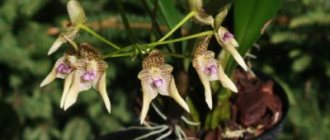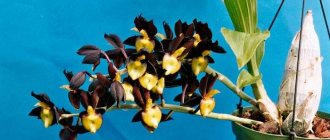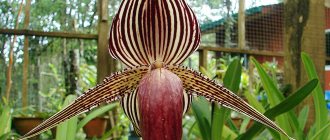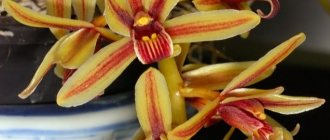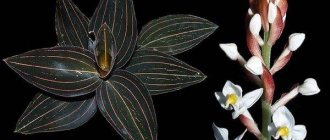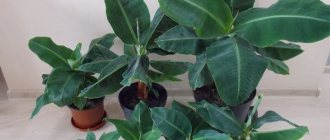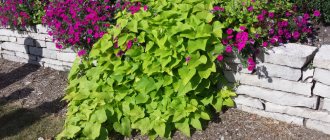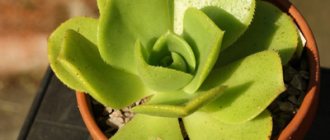Home care
Different types of Paphiopedilum are selective in their conditions of detention. In nature, they grow on calcareous and clayey soils, under trees (less often on trees). There are general rules for care, but each species group needs an individual regimen.
Temperature
It is advisable for all varieties to ensure a difference in night and day temperatures of +3...+5 °C.
Heat-loving mode:
- orchids with narrow, monochromatic leaves - +18...+22 °C in summer, +15...+17 °C in winter;
- with narrow spotted leaves - +23 °C in summer, +18 °C in winter;
- species and hybrids with wide spotted leaves - +20 °C in summer, +17 °C in winter;
- continuously flowering varieties - +22 °C in summer, +19 °C in winter.
Lighting and location selection
Daylight hours are at least 12 hours. Most species require bright, indirect light. This is a must for a multiflora group with monochromatic leaves. There are shade-tolerant and even shade-loving plants - most often orchids with marbled leaves.
Watering and humidity
At the optimal temperature, air humidity of 40–50% is sufficient. If the heat level increases, the humidity is increased to 60-70%. Water as the top layer of the substrate dries, and during the dormant period after complete drying.
Substrate and pot
It is better to choose a small and slightly cramped pot, with a wide neck, with a height of 15 cm. It should have holes for aeration and water drainage.
The substrate is neutral, slightly acidic or slightly alkaline. It depends on the type of orchid. It is collected from different fractions of pine bark, shells, coconut chips, small pebbles, crushed stone, peat and moss.
Transfer
Young plants are replanted every year. Adults - as necessary, once every 3 years.
Indications for transplantation:
- cramped pot;
- root rotting;
- planned change of substrate;
- pest damage.
The video shows how to properly transplant paphiopedilum:
https://youtube.com/watch?v=HUlCBxsz2lE%22+frameborder%3D%220%22+allow%3D%22accelerometer%3B+autoplay%3B+clipboard-write%3B+encrypted-media%3B+gyroscope% 3B+picture-in-picture%22+allowfullscreen%3E%3C
Top dressing
Organic fertilizers alternate with mineral compounds for orchids (1/3 of the standard norm). Feed 2 times a month. During the dormant period, fertilizer is not applied.
Reproduction
Propagated by dividing the bush when the orchid has grown at least 9–12 rosettes. The rhizome is dissected so that each section has at least three rosettes. It is better to propagate in the spring, immediately after the dormant period.
During flowering
Paphiopedilums bloom once or twice a season, each species consistently at the same time.
During flowering, it is better not to disturb the orchid; the care schedule remains unchanged. After flowering, the crop is transferred to dormant mode.
Diseases and pests
Due to errors in care (cold watering, lower temperatures, wet substrate), fungal diseases develop:
- late blight;
- rhizoctonia;
- anthracnose
In such cases, the substrate is changed, and the plant is treated with a fungidide appropriate to the problem.
Main crop pests:
- scale insects and mealybugs - wipe the leaves with soapy water and remove insects;
- spider mite - the bush is doused with a hot shower, the substrate is changed and the plant is treated with Fitoverm.
Paphiopedilums, unusual in their grace, will become a worthy decoration in the collections of orchid connoisseurs.
To avoid problems with care, when purchasing, it is important to obtain information about the origin of the species
Appearance: detailed description and photo
The tiger orchid is the most famous species of flower in the orchid genus. Its leaves are either oblong or broadly lanceolate in shape. The lower part of the leaf is covered with small brown spots. Flowering duration is 1 month.
The color of the flowers varies between white, yellow and red with small splashes.
A distinctive feature is the presence of jagged callous outgrowths, which are located immediately at the base of the lip. It is white with a cream tint, has single red spots, and is round in shape. At its base there is a fleshy ridge.
The peduncle is curved, grows from the axils of the lower tier of leaves, and its length is approximately 30 cm. The number of flowers can reach up to 9. The diameter of the flower is 15 cm. The sepals are lanceolate with a curved edge downwards, their color is yellow with large brown stripes. Occasionally you may find flowers with reddish-brown flowers.
Representatives of other orchid genera
Dendrobium Anna Green
The orchid of this species is endowed with spectacular and unsurpassed beauty. The large flowers resemble a butterfly in shape and are yellow-green in color.
At the core of this plant there is a dark purple tongue, which stands out against the background of light green flowers.
Cattleya bowringiana Green Garden (Cattleya bowringiana)
One of the most sophisticated and noble species among orchids. The petals are painted in the most delicate shade of green. The peculiarity of this flower is a kind of waxy coating, which makes the surface of the petals slightly glossy.
In the “green garden” variety, the petal at the core is unevenly colored lilac and light green, which makes the plant even more irresistible.
Cymbidium Green Giant
This is a separate genus of orchids that includes several different plant names. Among these flowers there are species with greenish petals and a tiger tongue.
Avid flower growers highly value the Sessa green variety; it is these orchids whose petals are colored richly green.
Brassavola digbyana
This orchid stands out brightly with long greenish petals and a shaggy lip. Brassavola also exudes a very subtle and unique aroma. This hybrid is primarily bred by experienced gardeners for cutting, as flower arrangements with this orchid variety look impressive and remain fresh for a long time after cutting.
Green orchids are a real highlight of the home flower collection. There are very few such natural colors in nature, so these varieties of orchids are an excellent find for exotic lovers.
The history of the orchid
The very first orchid epiphytes were discovered by Georg Rumph on the Moluccas, and numerous phalaenopsis hybrids were created much later. Presumably this type of orchid belongs to Taiwanese hybrids. Like many species of epiphytes of this selection line, they have a compact rosette, noticeable dots on the petals and a leopard-like core.
How to propagate?
There are several ways to propagate tiger orchids.
- The first method is to separate the root child, from which a new flower can grow.
- Branch of a baby on an orchid peduncle. You can find them on dormant buds and grow a new orchid.
- Growing a new flower from a dead one. If the orchid has died for some reason, you should not throw it away, since on the “stump” of the orchid you can find one or two children, from which you can get a new, more flowering plant. Children from the “stump” usually grow very well and easily perceive separation and transplantation.
Varieties of garden orchids
The following characteristics distinguish garden orchids from each other: planting - different varieties require different days for planting and different technologies, watering - some varieties do not tolerate excess moisture, others, on the contrary, prefer more water, reproduction - different conditions are created.
Kinds:
- Pollenhead is long-leaved or red. A type of outdoor orchid, it belongs to the monocotyledonous class. The plant is perennial, long-growing - capable of reaching 70 cm in height. It easily adapts to changing environmental conditions, so it grows in any area. The roots are strong, but easily susceptible to fungal diseases. The most common color is snow white. From the outside, the pollen head looks like a tall lily of the valley, but the buds are somewhat larger.
- Lyubka. The smallest orchid species of all. Small buds, located on the stem in large quantities, often have a greenish tint or boiling white with green veins. It prefers a humid environment, so in the wild it is often found in damp, swampy areas. Peculiarity of the flower: when it blooms throughout the summer, it emits a particularly strong aroma during rain and thunderstorms and at night. For this feature, Lyubka is often called “night violet”. The leaves seem to be divided into two parts. A variety that easily takes root in the northern and western regions.
- Cremastra Variable. It is difficult to care for this kind of plant. It requires constantly organized fertilization, regular watering and weeding, getting rid of pests and preventing their occurrence.
- Lady's slipper. The petals are usually found in a soft pink color, and the bud is painted in a bright fuchsia shade. It is often compared to unusual living butterflies and is easily confused from afar. This is a solitary flower, so it needs careful protection from pests.
Distinctive features of the variety
The Latin name of the orchid is Phalaenopsis Chengdu.
The main feature of the variety is that its petals are rich pink with barely noticeable inclusions, and the center of the flower is golden, with dark spots. Characteristics of the type:
- stem from 70 cm to 1 meter – 60–70 cm;
- the root system is aerial, capable of photosynthesis;
- the leaves are dark green, oval in shape, reaching 20–25 cm in length;
- There can be up to 20 flowers on a peduncle at the same time.
What it looks like: description and photo
The largest orchid in the world is considered to be the Grammatophyllum speciosum species, belonging to the Tiger variety. The appearance of the plant resembles a reed, which is why this orchid is popularly called the sugarcane orchid. For her high growth - reaching 7.62 m, she was included in the Guinness Book of Records, and for her impressive appearance and beauty she was awarded the title of Queen of Orchids.
The flowers of this plant have a characteristic yellow color with brown-red spots.
The color is very bright, eye-catching, “predatory”, so the plant was called “Tiger Orchid”
Reference! Each inflorescence reaches up to 3 m in length, and the diameter of the flowers included in it is up to 15 cm. One inflorescence can have from 60 to 100 such flowers.
They are located so close to each other that they seem to be one whole. The giant orchid weighs about 2,000 kg. It does not bloom every year, but the flowering period can last several months depending on care and maintenance conditions. The lifespan of an orchid is up to 50 years.
See photos of Grammatophyllum speciosum:
Proper care at home
In order for the plant to please its owner, it is necessary to pay special attention to certain care conditions:
The soil
You need to choose soil for your plant with extreme caution, because the amount of nutrients depends on the soil. The soil should consist of pine bark, cones and sand
Organic components are an integral part of the soil. Among other things, you should not forget about feeding the plant, because the roots require mineral salts and elements.
Humidity and temperature. The tiger orchid requires temperatures of no more than twenty-five degrees, so it is not recommended to allow a decrease. Air humidity should be 70%, so if such indicators drop, then you should do everything possible to bring them back to normal.
Lighting This plant loves light and warmth, so you should pay great attention to lighting. During the day, the orchid should bathe in sunlight. At night, fluorescent lamps should be on. Of course, their number should not be particularly huge.
Watering. It is not recommended to water the plant with hard water, because it can damage the roots.
IMPORTANT! You should not allow water to stagnate in the pot, so you need to check the drainage under the pot and remove excess water if possible. Articles by our experts on such varieties of orchids as Multiflora, Philadelphia, Wild Cat, Dracula, Big Lip, Beauty, Lady's Slipper, Cambria, Mix and Vanilla are devoted to proper care at home, as well as a description of their appearance.
Phalaenopsis care
When leaving, it is important to consider the following rules:
- Watering. Usually the orchid is watered very sparingly as the substrate dries with water at room temperature.
- Substrate. For Phalaenopsis Chengdu, you can use expanded clay, large tree bark, and coal as soil. At the same time, it is important to take care that the internal filling of the pot, when planting the plant in the container, does not tightly adjoin the aerial roots of the flower.
- Temperature and humidity. In the summer, the Chengdu phalaenopsis orchid feels good at a temperature of at least +20...+25 degrees, and in the cold season - from +15 to +18. The air humidity in the room where the tropical beauty grows can range from 60 to 80%.
- Lighting. This plant loves diffused sunlight. In autumn and winter, you can place it under a fluorescent lamp.
- Choosing a location. The orchid feels comfortable in a large glass or plastic pot on a warm floor or shelving. In this case, its roots are actively saturated with chlorophyll.
- Transfer. Phalaenopsis Chengdu is replanted as needed or immediately after purchase from a flower shop. You don’t have to wait for the orchid to bloom, but replant it with the flowers it already has.
- Reproduction. This variety of orchids reproduces well with the help of children, which are formed from the lower buds of peduncles. When replanting, you need to wait until the children themselves have roots. You can also use dividing the rhizome of an adult plant. The separated parts, as a rule, are processed before planting and placed in a pot with a ready-made substrate.
Analogues suitable for growing at home
The Tiger Orchid is unique and, due to its size, is not suitable for growing at home, but there are plants that look similar to it and are quite comfortable to keep at home. We are talking, first of all, about Maxillaria Cucullata and Rossioglossum major.
Maxillaria Cucullata
Fragrant beautiful guest. Grows in South and Central America, the Caribbean islands and South Florida. The scarlet color of the sepals in the center is dispersed by red dots. The petals are located parallel to the lip. The lip has a skirt that looks like a container. The outer side is yellow in color and the leaves are narrow. The bulbs have a round shape.
Rossioglossum Grande
It is a member of the orchid family, but is much larger in size and has a distinctive color. Grows in Guatemala, Mexico. The peduncles are strong, straight, with up to 8 buds in the raceme, 15 cm in diameter. The plant is not poisonous, but can cause an allergic reaction.
Useful video
In the video, consisting of two parts, you can see the process of transplanting a Chengdu orchid:
This rare type of orchid does not require much time from the grower to care for and is quite suitable for growing at home. It is only important to follow the basic rules of watering, temperature conditions, transplanting and wintering Chengdu phalaenopsis. Then this pink beauty with a leopard-print tongue will delight the eye with its colors for a long time.
Find out interesting things about other groups and varieties of phalaenopsis: Big Lip, Golden, Wild Cat, Stone Rose, Kimono, Cleopatra, Legato, Liodoro, Manhattan, Mix, Mini, Multiflora, Narbonne, Parrot, Ravello, Sogo, Surf Song, Frontera, Charmer , Schiller
Transfer
How to properly transplant an orchid at home, at what point? Sooner or later the time comes when it is necessary to do this. There are many reasons for this, such as the age of the plant or a cracked pot.
The transplant is performed carefully, according to all the rules. Only non-flowering plants are replanted. This process is approached thoroughly. At the slightest wrong action, the flower may die.
This variety must be soaked in water before transplanting to make it easier to remove from the container. This method causes less damage to the roots. The plant is carefully removed from the pot. All damaged roots are removed, the old substrate is completely removed. The roots are washed with warm water.
The plant is allowed to dry for about twenty minutes. Root sections are sprinkled with activated carbon to prevent infection. Place it in a new pot and only after that the container is filled with substrate.
The transplanted flower is fixed in the pot so that it does not fall. After transplantation, the plant is watered.
Flowering period
During the flowering period, problems may arise from watering the flower with cold water, sometimes too much and too often. Also, brown spots appear on the leaves of the flower due to a sharp change in temperature in the room. In the daytime, this heat-loving plant prefers a temperature of +25, and at night at least +18 degrees. In the case when the orchid does not bloom for a long time, you can add a complex of fertilizers to the water for irrigation.
Step-by-step instruction
- Transportation of an orchid in a flask intact and safe from Thailand to Russia.
- Place it on a windowsill where there will be suitable conditions for growth in the future (temperature, air humidity, lighting).
- Buying a pot with transparent walls to replant it.
- Substrate preparation (moss + clean fine bark/bark + coconut chips + moss). The bottom of the pot is covered with pebbles or broken pottery for drainage.
- Removing from the flask.
- Carefully place it in the pot and fill all voids in it with substrate.
- Organizing proper care for the transplanted orchid.
Before moving
Before transplantation, the vessel with the orchid is placed in the correct environment. It is placed on the windowsill, where there will be no drafts and where she is not in danger of hypothermia. They will grow it on it even after transplantation.
How many seedlings are inside the flask? 3-5 or several dozen.
Transplanting from a flask to a pot
There are several ways to remove an orchid from a flask. Some people think that the flower will not be stressed if it is taken out through a narrow neck.
Others prefer to wrap the container in cloth or newspaper and then break it by using a handy object. Who is right? The second method is preferable, since it allows you to save all the leaves that have appeared and not damage the root primordia when removing them.
Professionals act differently, pulling out seedlings by adding water to a transparent container
Also, if it is not glass, but plastic, simply cut it and take all precautions when removing fragile seedlings
- After removing the plant from the flask, free it from excess agar.
- A bunch of sprouts are washed under running tap water and then dried thoroughly using paper towels.
- The seedlings are sprayed with a solution of the fungicide Fundazol or Fitosporin.
- Wait half an hour, and then place them in a pot, sprinkled with substrate.
Attention! As soon as the seedlings are transplanted into a pot and the roots are sprinkled with substrate, move it to a warm and bright place. They are watered because they perceive a lack of moisture painfully.
Watering should be frequent.
Adult orchids are watered less often. Also, seedlings need feeding, but when preparing the fertilizer, they do not dilute it in the same proportions as in the instructions: there should be more water in it, and less active substance. If the rays of the sun rarely look into the window, you will need fluorescent lighting.
Below is a visual video about transplanting seedlings from a flask:
You will learn how to choose the right pot for this in a separate article, and read about how to plant seeds, bulbs or baby plants here.
Aftercare
After transplanting the seedlings, cover the pot with plastic wrap or glass. This is done in order to create conditions the same as in the flask; as in tropical latitudes, where it is hot but the air humidity is high.
Condensation on the walls of the pot or on the glass is dealt with by daily wiping and airing. This will prevent root rot in the seedlings.
As soon as the orchids have real roots, the care is changed. Glass or plastic film is removed and watering is reduced.



